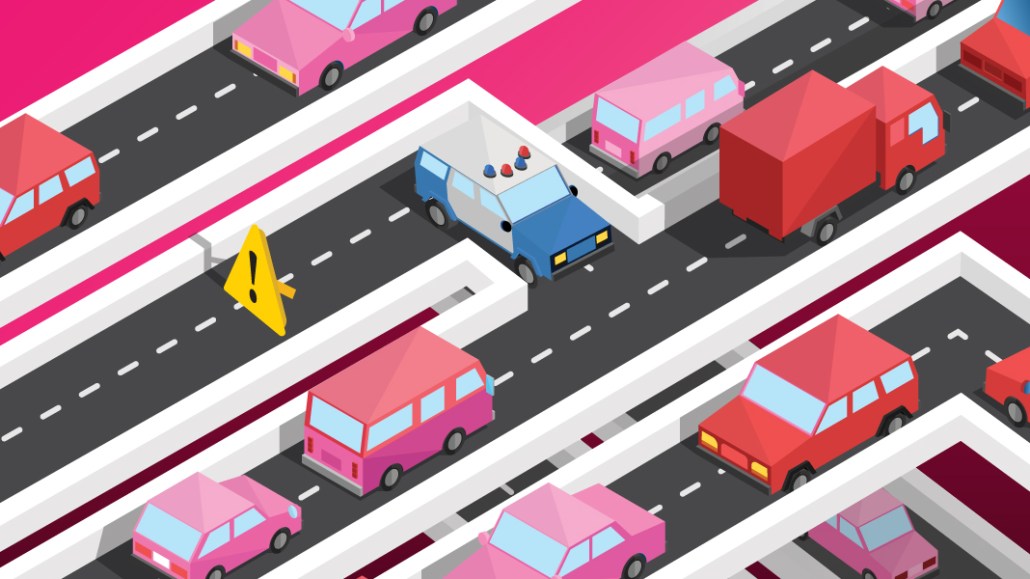Register by Jan 13 to save on passes and connect with marketers from Uber, Bose and more

All content has the potential to be unsafe — the definition of “safe” content varies from brand-to-brand. It’s a tricky landscape for advertisers who want to err on the side of caution, and entirely unhelpful for publishers looking for ways to ease advertisers’ brand safety concerns.
Safety concerns are even causing some media buyers to avoid news-related content altogether. A survey of 400 media buyers by Digiday found that 43 percent of respondents say they explicitly avoid advertising next to the news.
Several years into the struggle for better brand safety, there is widespread dissatisfaction fueled by countless incidents and violations. In fact, our survey of over 300 Digiday audience members, made up of brands, agencies and publishers, shows that blunt brand safety tools are stifling reach and content for both the demand and supply side.
Advertiser dissatisfaction with brand safety solutions
Advertisers are increasingly putting pressure on the industry, from platforms to publishers, to ensure that safe environments are a priority. That has been a catalyst for the creation of an entire catalogue of solutions, tools and technologies marketed toward the cautious.
With 85 percent of advertisers currently using brand safety technology or tools for more than a year, it’s vital that that investment is effective. But the study shows that 61 percent of advertisers are very concerned that today’s tools are insufficient to deal with the problem of brand safety.
“It’s entirely unsurprising that so many brands are concerned that brand safety tools are insufficient,” says Sacha Wilson, a partner at law firm Harbottle & Lewis with expertise in advertising, technology, digital and data privacy. “In practice, a brand could have the most robust risk allocation clauses in its contracts with agencies and vendors, but once a reputational issue has arisen, contractual remedies after the fact are unlikely to provide much comfort for a brand.”
The discomfort goes beyond damaged brand reputation for many advertisers. Our research shows that it’s limiting reach and could lead to brands switching off controls. Ninety-five percent of brands agree that brand safety blacklists or whitelists have a tendency to limit reach and 92 percent would forgo the use of brand safety tools if they were not achieving adequate reach for their campaign.
Ryan Kangisser, digital partner at media advisor MediaSense, says clients have mentioned a lack of (or diminished) reach when using brand safety measures but that it “has become an inevitable and acceptable trade-off to mitigate risk”.
Who’s responsible for brand safety?
“We’ve become very good at finger pointing and not so good at taking responsibility,” says Leena Vara-Patel, operations and ad tech director at agenda21. And while Vara-Patel does think publishers should play a more active role in policing brand safety, she says “it’s not solely their responsibility”.
Ninety-three percent of advertisers agree that publishers should play a more active role in policing brand safety and 68 percent of believe publishers should offer increased transparency into where placements appear to help address safety issues.
It’s not just an issue of responsibility, particularly as publishers also show concern over blunt brand safety solutions. The research shows that 84 percent believe first generation brand safety solutions are over-blocking safe content on sites, which has serious consequences for publishers around monetization and editorial content strategies.
“Those who own premium content and safe environments have the biggest chance to answer tomorrow’s concerns,” according to Stephane Coruble, CEO at RTL AdConnect. “When talking with brand owners, we observe that something clicks into place when we show them that there are publishers who offer the chance to advertise within curated content in a brandsafe environment,” he adds. “Advertisers need an alternative to digital giants, they need transparency and quality.”
What’s next for brand safety?
The study reveals a call for the adoption of technology that allows advertisers customize their brand-safety controls and ensure they accurately block what’s bad for their brand, without overblocking and losing scale. Another important step being demanded by the industry is that publishers should take on a more proactive role in policing brand safety from their end.
The next steps for brand safety lie in customization for advertisers and new and more sophisticated solutions and empowering publishers; if these two components become a priority there could be real progress in solving brand safety.
The full report, Why advertisers turn off brand safety controls, can be downloaded via this link.
More from Digiday

Why publishers are building their own creator networks
Publishers are forming creator networks to regain control, combat traffic declines, and reach audiences shifting toward influencers.

At CES, Omnicom Media says Walmart purchase insights help it make better use of Meta’s influencer followers
The partnership connects Walmart customer purchase data with Meta’s raft of influencers (via Instagram) to empower Creo to to help brands identify potential creator partners.

Ad Tech Briefing: CES marks the opening of digital advertising’s (likely) year of consolidation
Platforms including Amazon and Reddit use the Las Vegas-hosted event to muscle in on advertising budgets traditionally controlled by ad tech vendors.





